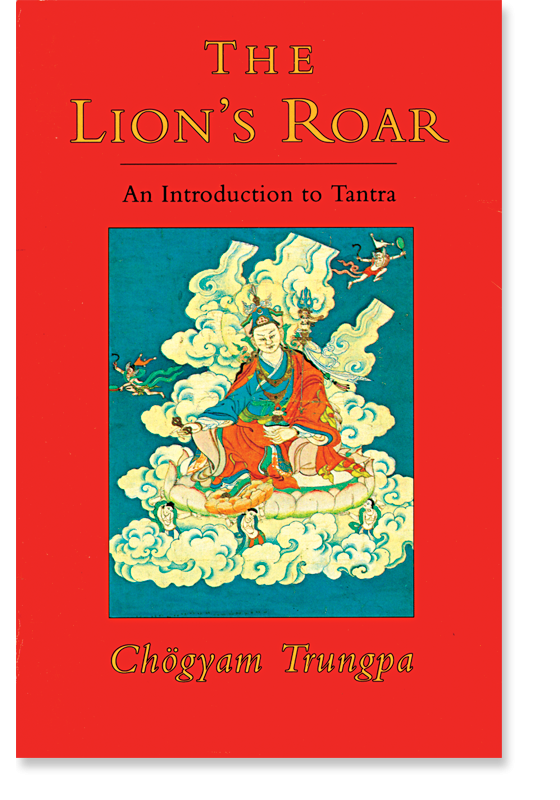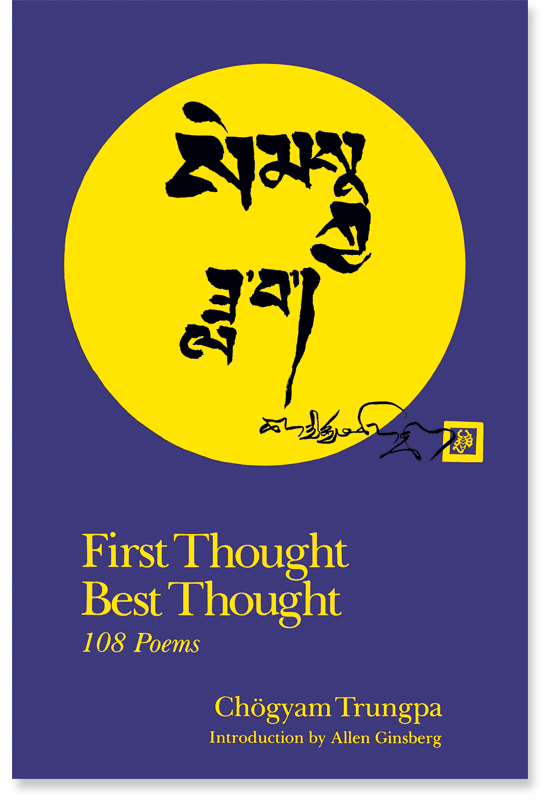Chogyam Trungpa - The Lion's Roar: An Introduction to Tantra
Extract From Chapter Six - Alpha Pure
As we said at the beginning, the journey through the nine yanas is a process of rediscovering oneself. As you move along the path, you have a feeling of particular locations. You are traveling through a dense forest or through heavy snow; you are climbing mountains or crossing fields; you encounter rainstorms and snowstorms. You have to stop each night to eat and sleep, and so on. All those experiences make up your journey. In a sense we could say that the rainstorms are your rainstorms, the snowstorms are your snow-storms, and the dense forests are your dense forests. It's your world. As you move through the nine yanas, it is yourself that you are rediscovering -more and more clearly.
At the beginning there is a vague idea that something is not quite right. There is something wrong with oneself. Things are questionable, and one begins to look into the question, to relate with the pain, the chaos and confusion. That is the hinayana level. Then at a certain stage some of the answers that arise out of the search begin to create further hunger, further curiosity. One~ heart becomes more and more steeped in the teachings. Then the mahayana experience of intense dedication to the path begins to take place. Dedication to the path in this case also means compassion, a loving attitude toward oneself and others. One begins to find one's place in the universe, in this world. Being on the bodhisattva path is finding one's place and one's sense of dedication in this universe. At that point, the universe is not threatening or irritating anymore. This is time for the very simple reason that one has developed a style for working with the universe; meditation in action has begun to develop.
As you go on then, you rediscover the brand-new world of tantra. An enormous surprise takes place. You recognize the magical aspect of the universe, which means yourself as well as everything else. You rediscover the redness of red, the blueness of blue, the whiteness of white, and so on. You rediscover the meaning of passion and the meaning of aggression, their vividness, their alive-ness, and also their transcendental quality. Rediscovering this new world is the vajrayana path.
At that point, not only do you realize the meaning of pain and confusion, and not only do you realize you have a place in the world, but you also develop a sense of dignity. In fact, you are the emperor of the universe, the king of the world. Your sense of dignity is related to the experience that you have an enormous place in this world. In fact, you are the maker of the world.
As the tantric experience develops through the lower tantras to the higher tantras, even the notion of being the emperor of the universe becomes unnecessary. You are the universe. You have no reference point, none at all. Everything is on the level of complete oneness. In higher tantric terms, this is known in Tibetan as kadak. Ka is the first letter of the Tibetan alphabet, dak means pure. So it means "pure right at the beginning," or you might say "alpha pure." Purity in this case has nothing to do with the relative reference point of pure as opposed to impure. Purity here has the sense of being really without comparison to anything, without any relative reference at all. That seems to be the state of development we are working toward. That, finally, is the level of the maha ati teachings, in which there is no reference point, none whatsoever. Therefore, in that state we find millions of reference points everywhere, which do not conflict with each other. Therefore we become precise and open, very general and very specific at the same time. That is the state of enlightenment, if it can be described at all in words. That's a sort of finger painting of the enlightenment idea.
The whole journey that we have discussed has its roots in overcoming spiritual materialism to begin with, then developing friendship toward oneself and others, and finally developing vajra pride, or a sense of dignity.1 Those three steps are the general guidelines for the hinayana, mahayana, and vajrayana, or tantra. And those experiences cannot come about without a teacher or master to begin with, on the hinayana level; a spiritual friend who minds one's business intensely on the bodhisattva or mahayana level; or, on the vajrayana level, a vajra master or vajra guru, who holds one's life strings in his hand.
There is a story about the abhisheka that the great tantric master Padmasambhava received from Shri Simha, the great sage of maha ati. Shri Simha reduced Padmasambhava to the form of the letter HUM. Then he ate it, he put it in his mouth and swallowed it. And when Padmasambhava came out the other end of Shri Simha, that completed his abhisheka. This is an example of the action of the vajra master. He is more than a teacher alone, more than a spiritual friend. The vajra master eats you up and shits you out, having completely processed you in his vajra body. That is the kind of power we're talking about. Without such a relationship, without this kind of communication, vajrayana cannot be presented. Without this, one cannot even come near to under. standing it. So relationships with the various levels of teacher are definitely requirements for progressing on the path.
Then, of course, there is the practice of meditation, which is another important part of the journey. One must practice meditation on the hinayana level in order to develop the basic sanity of relating to one's mind as a working basis. The satipatthana methods of mindfulness developed in the Theravada tradition are very powerful and important. The methods developed in the Sarvastivadin hinayana tradition that exists in Tibet, Japan, and China are identical.
When I was in India, I discussed meditation techniques for awareness practice with a Burmese master who was the disciple of a very great Burmese meditation teacher. When I told him about the vipashyana meditation technique that we used in Tibet, he shook his head and asked me, "When did you go to Burma?" So the methods seem to be identical.
It is necessary to begin at the beginning with the hinayana practice. Without that, we do not develop proper sense perception, so to speak. We have to have good eyesight and good hearing to read and listen to the teachings. And we have to have a good body in order to sit and meditate. Good sense perceptions here mean sense perceptions that are no longer distorted. We can have real understanding, no longer distorted by neurosis. That is absolutely necessary; there's no other way at all, according to Buddha anyway.
Having that solid rock bed for a foundation, that solid, sane, open, fresh ground, you can begin to build, to put up walls. That corresponds to the mahayana discipline of the six paramitas and friendliness to oneself and others. This gives us a sense of direction about how to act as good citizens, which is the bodhisattva path. After one has become a good citizen, there is an enormous possibility of becoming a genius. Basic sanity has developed and a proper lifestyle has been established. There are no hassles, no obstacles at all. Then you become a genius, which is the vajrayana level.
You become a fantastic artist, musician, sculptor, or poet. You begin to see the workings of the universe in its ultimate, last details. You are such a genius that you see everything completely. That's the final level.
This genius is described as jnana, wisdom. There are five types of genius, five wisdoms. There is mirrorlike wisdom, which is clarity. There is the wisdom of equality, which is seeing everything!~ at once in a panoramic vision. There is the wisdom of discriminating awareness, which is seeing details on an ultimately precise level. There is the wisdom of all-accomplishing action, in which speed does not have to be included in one's working situation, but things fall into your pattern. Then there is the fifth wisdom, the wisdom of dharmadhatu, or all-encompassing space, which develops enormous basic sanity and basic spaciousness in the sense of outer space rather than space that is related to the reference point of any planet. That is the kind of cosmic level of genius that we find in the vajrayana.
I suppose this seminar cannot be any more than a teaser for you. But at least you should know that millions of great people have been produced by this path; and not only have they been produced, but they all say the same thing. They've all gone through the same process that is being presented here. And we are not excluded from the possibility of becoming one of them. According to the Buddha, one out of every four people in the sangha becomes enlightened.
What we have done very roughly in this seminar has been to give a complete description of the path from the beginning stages to enlightenment. I hope you will have a sense of aspiration and feel joyful about what we discussed. The other possibility is that you might feel depressed, because you have heard about so many possibilities and good things, but none of them seem to apply to you. Well, okay, be that way-and use your depression as realization of the truth of suffering. Then you will have accomplished the first step already. Or if you are inspired, then buddha fever, the fever of buddha nature, has already possessed you. So let it be that way. It seems that whatever we do, we can't go wrong.






